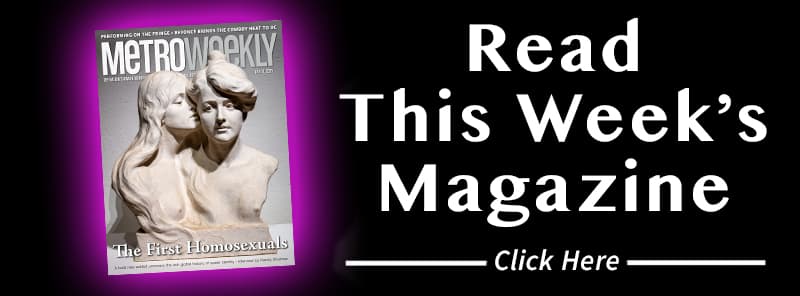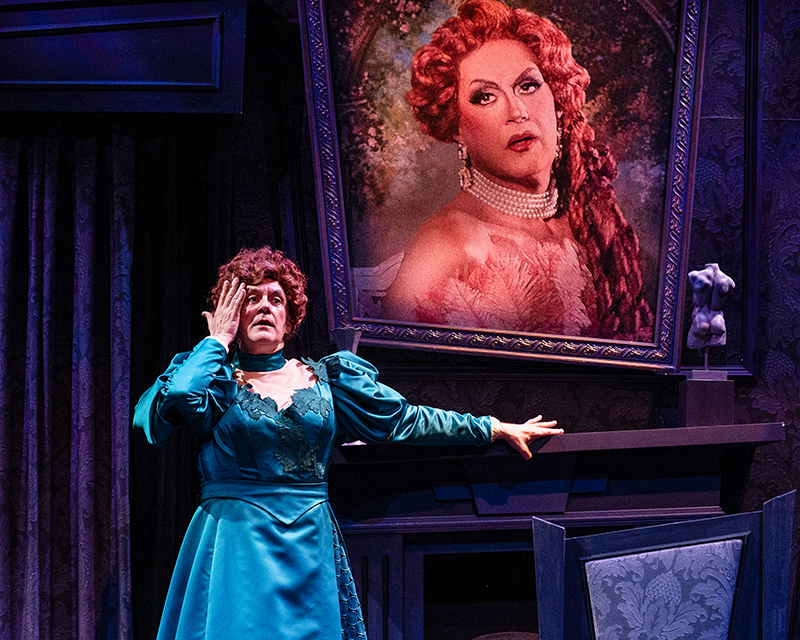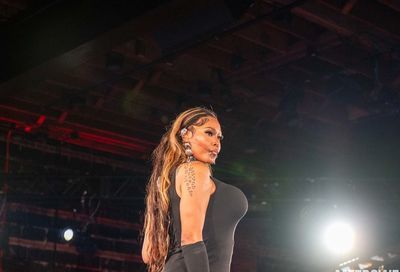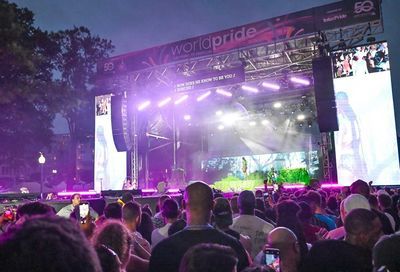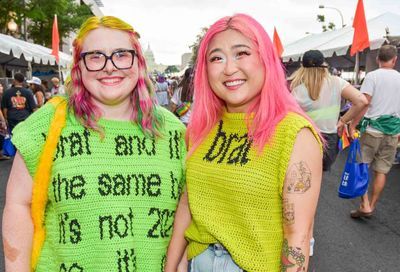20 Questions for Metro Weekly
20 Years of Metro Weekly
1. Where do you see Metro Weekly five years from now?
As Metro Weekly celebrates its 25th Anniversary, we imagine continuing with two distinct experiences: print and online. As printing technology will likely be about the same, you’ll still see our glossy issues around the metro area. How we design the layout may be vastly different. (Think holograms.) If 20 years has shown anything, it’s that we don’t stay still for too long, even if you can expect the same great content. As for online, well, that might be anyone’s guess. Maybe you’ll be reading Metro Weekly‘s latest on your Google Glass, or streaming Metro Weekly video through your implanted cerebral iChip. It’s bound to be a breathtaking ride.
2. What was your favorite Halloween costume over the years?
Many amazing Halloween costumes have appeared on our pages, but the most memorable appeared as a full page in 2003. The costume a hilarious, tasteless tribute to the mauling of Roy Horn (of Siegfried and Roy) by one of his beloved white tigers (because it’s always a good idea to put your head in the mouth of a tiger). The fetching costume featured ample blood splatter and a decapitated Roy head. We didn’t learn till many years later that the person adorning said costume was JR.’s manager Dave Peruzza, who a decade later dressed up for our own Halloween cover as a blood-drenched Carrie.
3. Why did you decide to have a Patron Saint for every issue?
The very first Patron Saint — Divine — appeared in the masthead of the Aug. 25, 1994, edition, which featured Priscilla, Queen of the Desert on the cover. The Patron Saint is sometimes a way for Metro Weekly to honor someone who has passed, whether a soul associated with the magazine, mentioned in an interview, or well known in the larger LGBT community. Other times, the Patron Saint is a chance to express our more playful disposition by employing a fictional character who has some bearing on a particular week’s content. Simply put, we have a Patron Saint because it’s another way for us to express ourselves and honor others.
4. What was MW’s very first feature or interview?
Ironically, it was a straight woman — Annie Adjchavanich, a photographer whose show, Biological Men, at the Hemphill Gallery in Georgetown, celebrated the illusion of drag in big, boldly dramatic, black-and-white prints. Dressed in male drag and clutching the rump of a faux Marilyn Monroe, Annie was photographed by Richard von Zimmer. In the fall of 1994, Annie joined Metro Weekly as its principal photographer.
5. What inspired you to start your own magazine?
Let’s put it as simply as possible. Randy Shulman was a film and theater critic working in D.C. He started contributing (under a pseudonym) to Michael’s Arts & Entertainment Weekly, eventually becoming its editor (under yet another pseudonym). When Michael’s abruptly closed shy of its own one-year anniversary, Randy turned to the suddenly unemployed staff and declared, “Let’s put out our own magazine! And this time let’s make it worth reading!” Three weeks later, on May 5, 1994, Metro Weekly made its debut.
6. Do you model your style after other print magazines?
It’s no secret among staffers that Randy is obsessed with The New Yorker (though Metro Weekly‘s in-depth “Q and A” interviews owe more to the DNA of “The Playboy Interview,” because gay men really do read Playboy for the interviews). Case in point: At least once a year, Randy bellows to the staff, “We’re going to move our calendars to the front of the magazine because that’s how The New Yorker does it!” And at least once a year the staff collectively retorts, “No.”
7. What has been the best cover celebrity “get” you’ve ever had, and how did it come to be?
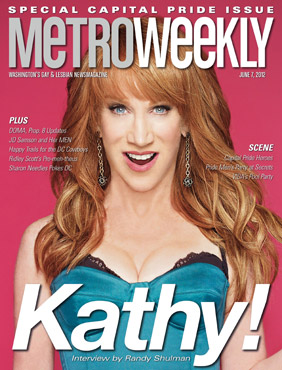
This is a tough one because it’s not just the gets, but the demands Randy puts on beleaguered publicists: “It has to be a one-hour interview or no dice.” (Normally, with a celebrity you’re lucky to get 20 minutes.) Sometimes it takes months to set up a basic interview. For that reason, we choose Kathy Griffin, who took a whopping four months to land. That said, we’ve been working on Barbra for 20 years. We’re still holding out hope.
8. Would you ever create an art book of all the original covers you’ve photographed or drawn?
Maybe not all, but most of our portraits, taken over the years by Todd Franson, Michael Wichita, Julian P. Vankim and Annie Adjchavanich, as well as cover illustrations by Christopher Cunetto, Scott G. Brooks, Linas Garsys, Stewart Haggas, Kendra Kuliga and Paul Myatt may one day appear in one of those massive tomes that puts a strain on your coffee table.
9. If Metro Weekly had an official mascot, what would it be?
How about a brightly colored tropical bird with a proud rainbow beak? We can call him Metro Beakly! Then again, we’d rather not get sued by the folks at Froot Loops.
10. If you could go back and re-do a cover, which cover would it be?
Admittedly, we’ve had our share of duds over the years, but there is one legendary cover affectionately known among staff as “Pee Cups.” We’d really like a do-over on that one, please.
11. Whatever happened to Hearsay, and just who was Hearsay anyway?
Depending on who you believe, Mark “Atlas Shrugged” Lee, Ed “My Kind of Town” Bailey or Eric “Lactating is Not Abnormal for a Man in My Condition” Hirshfeld, Hearsay either decided that Nightlife was dead and took a vow of silence after joining the Holy Order of Monkfish, works as a bartender at the city’s newest nightspot, Number 3.14159, or helps rid Eric daily of his excess Vitamin-D enriched milk. The identity of Hearsay has never been uncovered, but Brett “Yeah, It’s a Big Nightstick” Parson swears GLLLUP is hot on the cold case.
12. How many people have worked for Metro Weekly? How big is the staff?
That’s a tricky number. At the moment, Metro Weekly has eight full-time staff. We have about as many more involved in some way, whether writing content, illustrating, photographing or otherwise contributing. Over the years, we calculate more than a 135 people have worked with us.
13. What’s the worst mistake that ever ended up in the magazine?
Art director Mike Heffner wrote a dummy caption as a placeholder for a news photo — “Mike and Jeff at some event we can’t remember” — and forgot to replace it prior to going to print. Okay, there probably have been worse errors, but we’re not admitting to them. Next question.
14. Will you eventually just be online only?
While Metro Weekly can only increase its online presence moving forward, that in no way means we plan to relinquish print to history. We love print! We love our pads and our smartphones and all the rest, but there is a special place in Metro Weekly‘s heart for print, for being fully accessible at no cost, for greeting you on the streets where you live and in the venues you frequent. We do, of course, hope you’ll recycle those issues you’re not reserving for your personal collection.
15. How long does it take to make an issue?
That’s a very complex question. Some pieces that appear in the magazine or online are the result of weeks of labor. Other items come together in an instant. Suffice to say, we’d always like more time. Anyone got a Tardis for rent?
16. Is the photographer guy I see out always so upbeat?
As far as we can tell, absolutely. Ward Morrison is the living embodiment of joy riding a unicorn across a rainbow. Unless it’s one of those weeks he’s doing “The Cleanse.” Then you may want to steer clear.
17. What was your most elaborate photo shoot ever?
“The Peeps Issue,” which appeared April 20, 2000. Working with the entire staff, photography director Michael Wichita set up a veritable Peeps sweatshop in an empty office space at 1012 14th St. NW, and constructed elaborate costumes and scenarios, which he then photographed for what was one of Metro Weekly‘s most memorable issues of that era.
18. Why don’t you have subscriptions?
Because we have better things to do with our tongues than lick stamps.
19. How do you pick the events you send a photographer to?
There are many considerations when it comes to assigning an event to a photographer. If it’s a bar other nightlife venue, we would look to special events or the last time a venue may have appeared in the magazine. Do we expect a big crowd? That’s very important, as a photographer coming back from an event with 20 people is not going to give us enough photos to fill a page. Some annual events are obvious, like the Human Rights Campaign’s National Dinner or AIDS Walk. We love to take pictures of the community and would likely cover more events if we had more resources. But, at the end of the day, it’s always a question of what’s happening, which photographers are available, and how much space we expect to have in the magazine.
20. What’s on your nightstand?
A lamp, an alarm clock, eyedrops, a half-eaten gummy bear, a half-empty coffee cup, a stapler, pink fuzzy handcuffs, an extra pair of nylons, exactly 14 cents in loose change, The New Yorker, Car & Driver, a copy of The Unbearable Lightness of Being, and, of course, the latest Metro Weekly.

Support Metro Weekly’s Journalism
These are challenging times for news organizations. And yet it’s crucial we stay active and provide vital resources and information to both our local readers and the world. So won’t you please take a moment and consider supporting Metro Weekly with a membership? For as little as $5 a month, you can help ensure Metro Weekly magazine and MetroWeekly.com remain free, viable resources as we provide the best, most diverse, culturally-resonant LGBTQ coverage in both the D.C. region and around the world. Memberships come with exclusive perks and discounts, your own personal digital delivery of each week’s magazine (and an archive), access to our Member's Lounge when it launches this fall, and exclusive members-only items like Metro Weekly Membership Mugs and Tote Bags! Check out all our membership levels here and please join us today!







